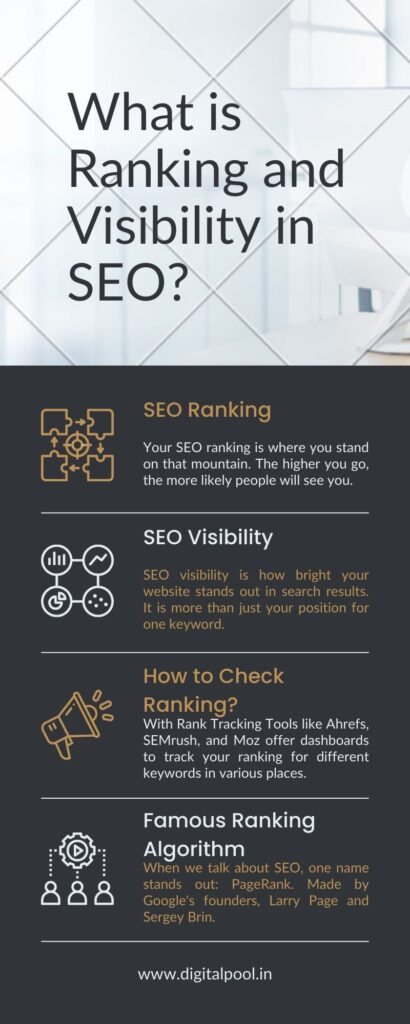Ever wonder why some websites show up first in search results while yours is not easily seen? The answer is in two important concepts for search engines: where you are on the list and how noticeable you are. Although people often use these terms interchangeably, they have different meanings in the world of search engine optimization (SEO). Let us explore these ideas and see how they work together to make your online presence better.

SEO Ranking
Think of search results like a mountain. Your SEO ranking is where you stand on that mountain. The higher you go, the more likely people will see you. This position is decided by complicated rules that Google and other search engines follow to judge websites based on different things, such as:
- Keyword relevance: How well your website content matches the words people use in their searches.
- Technical SEO: Is your website set up, mobile-friendly, and quick enough for search engines?
- Backlinks: How many Quality websites backlink to yours, showing support for your content.
- Quality content: Does your website provide interesting, informative, and useful content that satisfies users?
Getting a higher ranking takes ongoing work to improve these things. It is like climbing a mountain, but getting to the top (top search results) comes with great advantages:
More website visitors: A higher ranking means more people see your website, which can lead to potential customers.
Better brand recognition: People tend to remember and trust websites that rank well.
Improved organic reach: Organic traffic means users find you through search, not paid ads, giving long-term benefits.
SEO Visibility
SEO visibility is how bright your website stands out in search results. It is more than just your position for one keyword; it includes several factors:
- Number of keywords you appear for: The more relevant words your site shows up for, the wider your visibility becomes. Strong keyword research will eventually help for acquire more visibility.
- Click-through rate (CTR): How likely people are to click on your website when they see it in search results.
- Brand recognition: Do people already know your brand, making them more likely to click on your result even if it’s not the first?
- SERP features: Do you appear in special sections of search results, like featured snippets or knowledge panels?
Higher visibility makes your website a standout in the digital world, attracting more visitors and boosting your online presence.
The Connection of Ranking and Visibility
Even though ranking and visibility are different, they work together. A strong ranking for a popular keyword can greatly increase your visibility. Similarly, having high visibility for many keywords can improve your overall ranking over time. It is a relationship where each part makes the other stronger, guiding your website to success in SEO.
What are the Three Stages of Ranking SEO?
Everyone wants their website to show up on search engines. But, to do that, you need a plan. Let us break it down into simple steps.
Step 1: Set the Base
Focus on things inside your site that search engines like:
- Fix the Technical Stuff: Make sure your website’s code is good, it loads fast, and works well on phones. It’s like making your fortress walls smooth for the search engine bots.
- Quality Content: Create good, relevant content that people like. Fill your fortress with things visitors will enjoy.
- Find the Right Words: Figure out the words people use to search for things related to your site. Use these words to guide visitors to your fortress.
Step 2: Spread the Word
This step is about things outside your site that help others find you:
- Get Good Links: Have other important sites link to yours.
- Use Social Media: Create a community around your brand on social media. Share interesting things to get more attention.
- Local Attention (if needed): Make sure your site is easy to find for local searches. This is important for businesses with a physical location.
Step 3: Regular Checks
This step is about keeping your audience and making the most of your SEO efforts:
- Check and Improve: Use tools to see how your site is doing. Change your strategies based on what works, like adjusting tactics in a battle.
- Update Content: Keep your content interesting and fresh.
- Good Experience: Make sure your site is easy to use and enjoyable.
How Do You Check SEO Ranking?
SEO ranking can seem confusing, but don’t worry! Understanding and checking your SEO ranking is not that hard.
Why Does SEO Ranking Matter?
SEO ranking decides where you are on the map, guiding potential customers to your door. A higher ranking means more people see you, more clicks, and more business.
The Tools You Need
You don’t need anything fancy to check your SEO ranking:
- Google Search Console: This official Google tool shows how well your website is doing in search results. It tells you which keywords you rank for, your click-through rates, and how mobile-friendly your site is – a treasure chest of SEO insights.
- Rank Tracking Tools: Websites like Ahrefs, SEMrush, and Moz offer dashboards to track your ranking for different keywords in various places. Think of them as powerful telescopes, zooming in on your competition.
- Keyword Checker Extensions: Browser extensions like Keywords Everywhere and SEOquake give quick snapshots of ranking positions for individual keywords on the search engine results page.
Other Important Tools
- Analyze Competition: Don’t just follow your own ranking – see who else is trying to get to the top. Use tools like SpyFu or Similarweb to understand your competitors’ SEO strategies.
- Track Keyword Trends: Keywords change in popularity and search intent. Tools like Google Trends can help you adjust your strategy to stay ahead.
- Monitor Technical SEO: A website full of errors is like a shop with a shaky door. Use tools like Google Search Console’s mobile-friendliness test and Google PageSpeed Insights to make sure your website is technically sound.
What is the Most Famous Ranking Algorithm?
Ranking algorithms, the secret keepers of search engine results, have a lot of say in deciding what happens to your website. Even though these algorithms change, some are always known as the most important. Let’s try to understand their secrets and give you the knowledge to tackle the SEO challenge.
- The Top Algorithm: Google’s PageRank
When we talk about SEO, one name stands out: PageRank. Made by Google’s founders, Larry Page and Sergey Brin, PageRank changed online ranking by treating the internet like a huge web of connected pages. Link building is like a “vote” of confidence, and important websites carry more weight.
- Google’s Hummingbird
In 2013, Google introduced Hummingbird, a big update that shifted towards understanding the meaning of words. Instead of just matching keywords, Hummingbird goes deeper, figuring out why someone is searching. It looks at context, similar words, and how users behave to give the most relevant results, even if the exact keywords are not there. This shows the importance of good content that really answers what users want, not just stuffing keywords.
- RankBrain
In 2015, Google brought in RankBrain, a machine learning wonder that studies how users react to search results. Think of clicking on a result, reading a bit, and then leaving because youre not happy. RankBrain notices this and understands it means the result was not what you wanted. Websites with lots of clicks and time spent on them move up in the rankings, while those causing frustration disappear. This shows how important it is to make your website a good experience for users.
Even though PageRank, Hummingbird, and RankBrain are powerful, SEO ranking is complex with many factors. Being easy to use on mobiles, having a fast website, good technical SEO, links from important websites, and having fresh, good content all matter. Remember, SEO is not just one thing; it is about making your website the most useful for users and search engines.
Remember, SEO is not a one-time thing. It is an ongoing process. Understand and follow these steps, and you will not only get on search engines but also build a lasting presence that attracts and keeps visitors. So, get ready, gather your team, and start your journey for SEO success!
